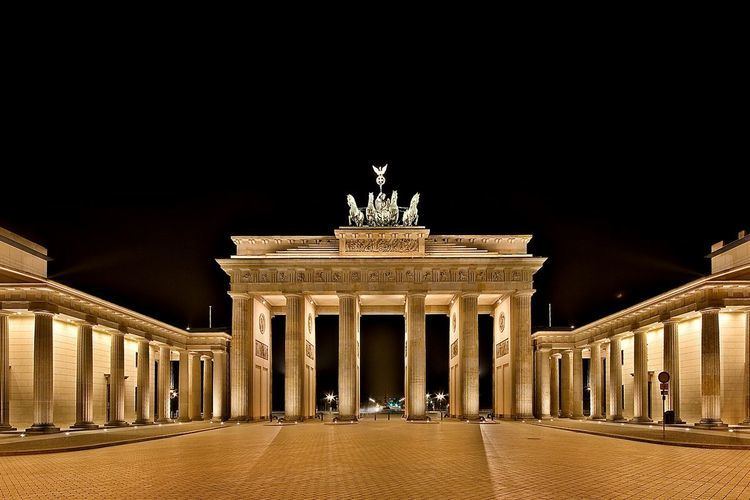Status Complete Completed 3 October 1969 Height 368 m | Location Berlin, Germany Main contractor GDR government Opened 3 October 1969 | |
 | ||
Type Television tower, Restaurant, Observation tower Address Panoramastraße 1A, 10178 Berlin, Germany Hours Open today · 9AM–12AMSaturday9AM–12AMSunday9AM–12AMMonday9AM–12AMTuesday9AM–12AMWednesday9AM–12AMThursday9AM–12AMFriday9AM–12AM Architects Hermann Henselmann, Fritz Dieter, Günter Franke Similar Alexanderplatz, Reichstag building, Brandenburg Gate, Berlin Cathedral, Museum Island Profiles | ||
The Fernsehturm (English: Television Tower) is a television tower in central Berlin, Germany.
Contents
Close to Alexanderplatz in Berlin-Mitte, the tower was constructed between 1965 and 1969 by the administration of the German Democratic Republic (GDR). It was intended as a symbol of Berlin, which it remains today, as it is easily visible throughout the central and some suburban districts of Berlin. With its height of 368 metres (including antenna) it is the tallest structure in Germany, and the second tallest structure in the European Union. Of three tallest structures in Europe, it is 0.5m shorter than the Riga Radio and TV Tower, and 8m taller than the Trbovlje Power Station in 2017.
The tower has become one of the most prominent symbols of the country and is often in the establishing shot of films set in Berlin. Due to its location near Alexanderplatz, it is occasionally called Alex Tower.
Overview
The original total height of the tower was 365 metres (1,198 ft), but it rose to 368 metres (1,207 ft) after the installation of a new antenna in 1997. The Fernsehturm is the fourth tallest freestanding structure in Europe, after Moscow's Ostankino Tower, the Kiev TV Tower and the Riga Radio and TV Tower. The sphere is a visitor platform and a revolving restaurant in the middle of the sphere. The visitor platform, also called panoramic floor, is at a height of about 203 metres (666 ft) above the ground and visibility can reach 42 kilometres (26 mi) on a clear day. The restaurant Telecafé, which rotates once every 30 minutes, is a few metres above the visitors platform at 207 metres (679 ft). When first constructed, it turned once per hour; the speed was later doubled following the tower's 1997 renovation. Inside the shaft, two lifts shuttle visitors to the sphere of the tower within 40 seconds. A Stairway with 986 steps also provides access, however it is not accessible by wheelchair.
To mark the 2006 FIFA World Cup in Germany, for which the final match was played in the Berlin Olympic Stadium, the sphere was decorated as a football with magenta-coloured pentagons, reflecting the corporate colour of World Cup sponsor and owner of the Fernsehturm, Deutsche Telekom.
History
In 1964, Walter Ulbricht, leader of the Socialist Unity Party which governed East Germany, decided to allow the construction of a television tower modelled on the Fernsehturm Stuttgart and the first artificial Earth satellite, Sputnik. The TV tower had several architects. Its former design was done by Hermann Henselmann, and Jörg Streitparth. It was built by the East German architects Fritz Dieter, Günter Franke and Werner Ahrendt between 1965-69. Walter Herzog, Gerhard Kosel and Herbert Aust later also took part in the planning. The Tower was deliberately constructed in the center of the historic medieval center of Berlin, resulting in the destruction of a huge portion of the historic center of the capital of Germany. A medieval church stands next to the tower as a testament to the destruction of the old city. Construction began on 4 August 1965. After four years of construction, the Fernsehturm began test broadcasts on 3 October 1969, and it was officially inaugurated four days later on the GDR's National Day. Regardless of its dark origins, it is among the best known sights in Berlin, and hosts around a million visitors a year.
"Pope's Revenge"
When the sun shines on the Fernsehturm's tiled stainless steel dome, the reflection usually appears in the form of a cross. Berliners nicknamed the luminous cross Rache des Papstes, or the "Pope's Revenge". For the same reasons, the structure was also called "St. Walter" (from Walter Ulbricht). U.S. President Ronald Reagan mentioned this in his Tear down this wall speech on 12 June 1987. It is also affectionately known as the Toothpick and Telespargel (TV-asparagus) due to its shape.
Technical details
Digital television (DVB-T)
Analogue TV stations
The analogue TV service was shut down on August 4, 2003.
